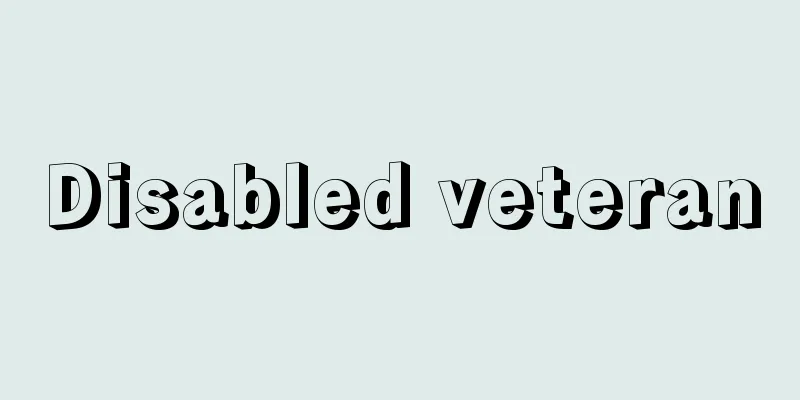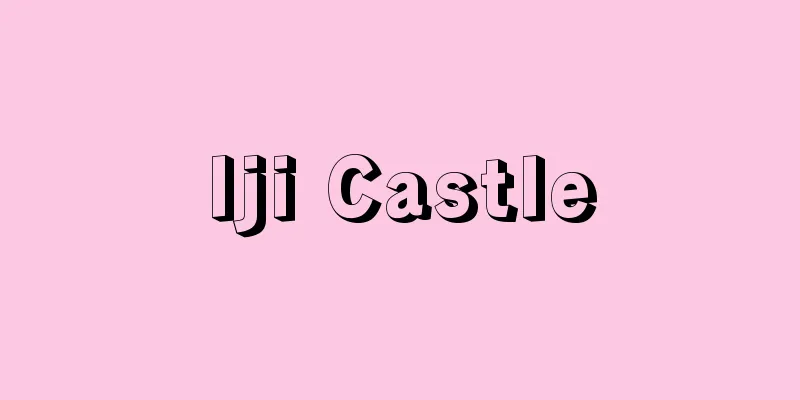Disabled veteran

|
A soldier or military personnel who was injured during battle or official duties. In practice, it refers to those who are eligible to receive increased pensions, invalid pensions, and invalid grants under the Military Pension Law. Invalidated soldiers were called "invalids" until November 1931 (Showa 6). In particular, the Russo-Japanese War caused over 36,000 injured soldiers, so the Invalidation Institution Law was enacted in April 1906 (Meiji 39), and the Invalidation Institution was established in Shibuya, Tokyo in September of the following year with the aim of providing lifelong support for the injured and sick by the state. Only invalidated soldiers who were unable to support themselves through their own assets or work were allowed to be housed in the Invalidation Institution. Other facilities for disabled soldiers were also partially used as shelters for them, such as the Keiseisha and garrison hospitals during the Manchurian Incident, where vocational training was provided. After the name was changed to "Wounded Veterans," as the Second Sino-Japanese War turned into an all-out war, many soldiers became sick and injured, and in April 1938, the Invalids' Home was renamed the Wounded Veterans Protective Home under the jurisdiction of the Ministry of Health and Welfare and expanded. The following year, it was renamed the Military Protective Home again, and not only did it provide medical care to wounded veterans, but it also made strong efforts to help them reintegrate into society through vocational training and job placement. At the same time, wounded veterans were given privileges such as exemption from railway fares, income tax reductions, and priority sales rights for cigarettes, and a generous protection system was in place by the state. After the Second World War, the Military Protective Institutions were abolished and disabled veterans were treated the same as ordinary physically disabled people, and from then on, they were supported within the framework of general physically disabled people. However, in April 1952, the War Wounded, Sick and Dead Survivors Assistance Law was enacted, which provided for lump-sum disability payments, rehabilitation medical care, provision of prosthetic devices, and placement in national sanatoriums, all at the expense of the national treasury, and measures for disabled veterans were re-emerged. In November of the same year, the Disabled Veterans Association was established, and as a local organization, a Disabled Veterans Association was established in each prefecture. In August 1953, the Pension Law was revised, and various privileges were granted, including free travel on the national railways. In 1963, these assistance-related laws were consolidated into the Special Assistance Law for War Wounded and Sick Veterans. Furthermore, prior to this, in February 1955, the Japan Disabled Veterans Association, which played an important role in the enactment of the law, became a foundation. The association has lobbied the government to improve the treatment of disabled veterans, and has also engaged in mutual assistance among members and published the journal "Nichishou Gekkan." In addition, since 2006, the association has been commissioned by the government to operate the "Shokeikan" war-wounded veterans' museum (Chiyoda-ku, Tokyo). However, the number of members, which was 350,000 at the time of incorporation, had fallen to about 5,000 by 2013, and it became difficult to operate the organization, so it was dissolved at the end of November 2013. The operation of the "Shokeikan" will continue with a new contractor. [Kokatsu Atsushi] Relief measures in other countriesLooking at examples from other countries before the Second World War, in the UK, organizations such as the Allied Army and Navy Aid Association and the British Red Cross Special Relief Committee, which were based on the voluntary efforts of civilian volunteers, provided relief to disabled veterans. In the US, the Assistance Bureau worked with the Pension Bureau, veterans' organizations, and veterans' associations to provide education and job placements to disabled veterans. In Germany, disabled veterans received vocational education at the Ministry of Labor along with ordinary physically disabled people, and various legal benefits were given to seriously injured or ill veterans who were eligible to claim a pension or a pension equivalent to reduced productivity under the German Relief Act and the Military Personnel Relief Act. In France, disabled veterans eligible to receive increased pensions could receive treatment from a doctor of their choice free of charge, and were given various benefits, including discounts on train fares, depending on the severity of their injury. In the former Soviet Union, state and public/private organizations also provided this, and tax exemptions and other measures were available. [Kokatsu Atsushi] Source: Shogakukan Encyclopedia Nipponica About Encyclopedia Nipponica Information | Legend |
|
戦闘または公務の際、傷痍を受けた軍人・軍属。実際には、軍人恩給法によって増加恩給・傷病年金・傷病賜金の受給権有資格者をさす。傷痍軍人は1931年(昭和6)11月まで廃兵と呼称された。とくに日露戦争によって3万6000人余の傷病者を出したことから、1906年(明治39)4月に廃兵院法が制定され、傷病者の国家による終生扶養を目的として翌年9月に廃兵院が東京・渋谷に設置された。廃兵院には、自己の財産・労働による自活能力のない傷痍軍人に限り収容を許可された。傷痍軍人の保護施設は、このほかにも満州事変の際の啓成社や衛戍(えいじゅ)病院内でも一部代用され、職業訓練等が実施された。傷痍軍人と名称変更後、日中戦争の全面戦争化に伴い、多数の傷病軍人が出た結果、1938年4月、廃兵院は厚生省管轄下に傷兵保護院と改称して拡充された。さらに翌年には軍事保護院とふたたび改称され、傷痍軍人に対して医療の便宜を図るだけでなく、職業訓練、就職斡旋(あっせん)による社会復帰への配慮が強力に実施された。同時に傷痍軍人には鉄道運賃免除、所得税減税、煙草(たばこ)等優先販売権などの特典が付与され、国家による手厚い保護制度が準備されていた。 第二次世界大戦後、軍事保護院は廃止され、傷痍軍人は一般の身体障害者と同等扱いとなり、以後、一般身体障害者対策の枠内で援護されることになった。ところが、1952年(昭和27)4月に戦傷病者戦没者遺族等援護法が制定され、障害一時金、更生医療、補装具支給、国立保養所への収容などが全額国庫負担で実施されることになり、傷痍軍人対策がふたたび登場することになった。同年11月には傷痍軍人会が発足し、地方組織として各都道府県傷痍軍人会が設置された。1953年8月には恩給法が改正された結果、国鉄無賃乗車の指定をはじめ各種の特典が付与された。なお、これら援護関係諸法規は、1963年に戦傷病者特別援護法に一本化された。また、これより先1955年2月には、同法制定に重要な役割を果たした日本傷痍軍人会が財団法人に移行。傷痍軍人の処遇改善を国に働きかけるとともに、会員の相互援助や機関誌『日傷月刊』の発行などを行ってきた。また、2006年(平成18)からは、国の委託を受けて戦傷病者史料館「しょうけい館」(東京都千代田区)の運営なども行ってきた。しかし、法人化時に35万人であった会員数は2013年には約5000人まで減少し、組織の運営がむずかしくなったことから、2013年11月末をもって解散した。なお、「しょうけい館」の運営は、新たな委託先により継続される。 [纐纈 厚] 諸外国の救護対策第二次世界大戦前の外国の例でみると、イギリスの場合、傷痍軍人救護には民間有志の自発的行為に基づく連合陸海軍人後援会、イギリス赤十字社特別救護委員会などの組織があたった。アメリカでは恤兵(じゅっぺい)局が恩給局、在郷軍人団体、老兵院委員会などと協力して傷痍軍人の教育や職業紹介を行った。ドイツの場合、傷痍軍人は一般の身体障害者とともに労働省で職業教育を受け、さらにドイツ救恤法、軍人救助法などによって恩給もしくは生産力減殺に値する年金請求資格を有する重傷病者にはさまざまな法律上の特典が与えられた。またフランスでは、傷痍軍人で増加恩給受給資格者は無料で本人の希望する医師の治療が受けられ、傷病の程度によって鉄道運賃の割引をはじめ各種の特典が与えられた。旧ソ連でも国家あるいは公私の機関がこれにあたり、免税措置などが用意された。 [纐纈 厚] 出典 小学館 日本大百科全書(ニッポニカ)日本大百科全書(ニッポニカ)について 情報 | 凡例 |
Recommend
Quellinus, A. (English spelling) QuellinusA
…Flemish painters who specialized in genre and la...
Red Eyebrow Rebellion
A peasant rebellion at the end of the Wang Mang (...
Instrument - Gauge
A general term for instruments and machines that ...
Turbinia - Turbinia (English)
The world's first steam turbine ship. Designe...
Fredholm - Fredholm (English spelling) Erik Ivar Fredholm
1866‐1927 Swedish mathematician. Born and died in ...
borderline case
…Case that is positioned on the border or between...
Revaluation of assets
The act of revaluing the acquisition cost of an a...
Whewell, William
Born: May 24, 1794, Lancaster [Died] May 6, 1866. ...
Aslinoe, C.
…However, with the outbreak of the French Revolut...
directional evolution
…This is the orthogenesis theory. Many modern evo...
Kingdom of Castile and Leon
…Politically, at the beginning of the Reconquista...
Médicis, M.de (English spelling) MedicisMde
In order to maintain the right of the priesthood ...
Kaftankai - Kaftankai
...The Salafiyya movement, which began with Wahha...
Mankiewicz, H.
…American film director, producer, and screenwrit...
muwalladūn (English spelling) muwalladun
...In time, the number of Muslims increased due t...








![Benjamin [of Tudela] (English spelling)](/upload/images/67ccd00c0a0bd.webp)
